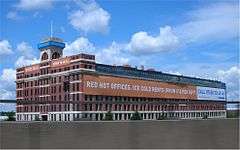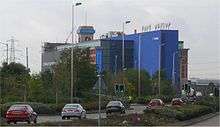Fort Dunlop
Fort Dunlop (grid reference SP129902), is the common name of the original tyre factory and main office of Dunlop Rubber in the Erdington district of Birmingham, England. It was established in 1917, and by 1954 the entire factory area employed 10,000 workers. At one time it was the world's largest factory, when it employed 3,200 workers.[1]
| Fort Dunlop | |
|---|---|
 Fort Dunlop from the M6 motorway, 2007 | |

| |
| General information | |
| Type | Office, retail and hotel (formerly industrial) |
| Location | Erdington, Birmingham, England |
| Coordinates | 52.5097°N 1.8120°W |
| Construction started | 1916 |
| Completed | 1920s (2006 in current form) |
| Height | 24 metres (79 ft) |
| Technical details | |
| Floor count | 7 |
| Design and construction | |
| Architect | 1920s: Sidney Stott and W.W. Gibbings 2007: Hazel Rounding of shedkm |
| Main contractor | Capital Properties (UK) Ltd |
| Awards and prizes | Grade A locally listed |

Fort Dunlop, the main building of the former factory area, is next to the M6 motorway, near to junction 5. It is a Grade A locally listed building.[2] It was designed by Sidney Stott and W. W. Gibbings in the 1920s.[3] The building's use was the storage of tyres and was called Base stores. An almost identical building housing administrative and general offices was located on Wood Lane. Dunlop Tyres now occupies a small part of the building.
History
The Dunlop Rubber Co. Ltd was set up in Birmingham in 1901 to manufacture Dunlop tyres, initially for bicycles and later for motor vehicles. The First World War initiated a huge expansion in the demand for solid tyres for lorries, and the Fort Dunlop factory was built in 1916 on a 120-hectare site on the east side of Birmingham. Post-war, the motor industry grew and Dunlop was well placed to supply the demand for tyres. In the 1970s it was still the largest tyre factory outside the United States, however, the increased number of foreign cars imported into Britain led to a decline in demand, the company was sold in the 1980s and large-scale tyre production ceased at Fort Dunlop in November 2000.[4] <personal experience> Dunlop Tyres continued to produce specialised vintage, motorcycle and motorsport tyres on the site. The factory was to close in September 2014, with production moving to Germany and France.[5]
Redevelopment
The company Urban Splash acquired the building and the 4.02 hectares (9.9 acres) of land[2] from English Partnerships in 1999 and started work developing proposals in conjunction with Advantage West Midlands, the regional development agency who funded the reclamation of the land.[6] Urban Splash possess the building by a 999-year lease from Advantage West Midlands.[2]
The Fort Dunlop building, derelict for twenty years (with the exterior used as advertising space), has been redeveloped into an office and retail space with an adjoining Travelodge hotel. Work on the redevelopment commenced in December 2004. It now has 300,000 square feet (27,871 m2) of office space[3] within the main building as well as recreational leisure space. There are also 1,150 basement and surface car parking spaces.[2] The developers were Urban Splash and the architects were Liverpool-based Hazel Rounding of shedkm.[7] The landscape designer for the building's setting was Martha Schwartz Inc.[8]
By March 2005, all windows and poor quality extensions were removed to reveal the shell. The steel structure which would house the 100-bed Travelodge hotel began construction and the largest advertisement hoarding in the world at that time was constructed on the front of the building. The steel structure was completed in June 2005 along with the roof structure. The concrete was added to the steel structure two months later. They were manufactured offsite and transported to the building where they were fitted into place. They contained the circular holes on one side to allow for the circular windows. By the end of 2005, the windows were being added to the inside of the building. The outside structure was left as it was and the glass structure was built behind it. The assembly work had been completed to the adjacent structure and work had begun to paint it dark blue with a sign saying "FORT DUNLOP" added to the top of the structure by March 2006. The sign is illuminated at night[9] The skyline signage, with its programmable, RGB LED illumination resulted in three separate industry awards for ASG, the company that designed, manufactured and installed the structures.[10]
By June 2006, the windows had been fitted to the Travelodge and the hotel opened to the public. Window work on the inside of the old building was being completed and the floor layouts were being defined.
Fort Dunlop opened by a ceremony on 1 December 2006.[11] The roof was covered by soil and grass, the largest such grass roof in the United Kingdom; it provides natural insulation and a wildlife reserve.
In August 2006, Urban Splash announced that three retail companies were to move to Fort Dunlop; house accessory specialist Dwell, relocating from the Custard Factory, Snap Galleries and a Birmingham-based coffee outlet named The Daily Grind Coffee Company.[12][13] Another company, Boxer, a design consultancy, was announced as the first tenant, relocating from their base in Coleshill.[14]
In 2015, Fort Dunlop had over 30 businesses in its office space, including: Trinity Mirror Midlands; Whistle PR; Ford Retail; Skills First; Nicol Thomas; and Overbury.
In 2017, Trinity Mirror Midlands relocated back to Birmingham City Centre having occupied the entire 6th floor of the building – all 53,582 sq ft. At over one acre in area, it was the largest open plan office space in the country outside of London.
During 2018, the 6th floor was refurbished offering the largest available floor plate in Birmingham at over 27,000 sq ft. [15]
Architecture
The early structure is of concrete, clad to a steel frame. Upon redevelopment, it was found that the steel frame had moved no more than 2 mm (0.1 in), a reflection of the quality of construction. The building is 52 metres (171 ft) deep. The south side measures 24 metres (79 ft) in height and 130 metres (427 ft) in width. The extension housing the Travelodge hotel extends 170 metres (558 ft) from the building, and has a width of 8 metres (26 ft). The northern facade is of slightly different architecture from the remainder of the building as it was damaged during World War II by bombing raids by the Luftwaffe.[8]
A circular light well was constructed from the roof to the atrium at the reception, allowing natural light to illuminate the middle of the building. At each floor, the light well is lined with steel to represent the industrial heritage of the building.[8]
References
- "Fort Dunlop". Everything2. 2003-01-30. Retrieved 2008-08-01.
- "Fort Dunlop, Fort Parkway, Birmingham". Drivers Jonas. Retrieved 2008-08-01.
- "Fort Dunlop, Birmingham". e-architect. Retrieved 2008-08-01.
- Hudson, Kenneth: Industrial history from the air, Cambridge University Press 1984
- Dunlop Motorsport Manufacturing Plant to Close - Sportscar365, 3 February 2014
- "Transformation of iconic Fort Dunlop". Buildingtalk. 2006-02-17. Archived from the original on 2007-06-08. Retrieved 2008-08-01.
- Archived June 8, 2007, at the Wayback Machine
- "A monument to growth". The Birmingham Post. 2005-12-20. Retrieved 2008-08-01.
- Jon Griffin (2006-03-02). "City landmark set to dazzle". Birmingham Mail. Retrieved 2008-08-01.
- "Sign Industry Awards 2007". Archived from the original on August 21, 2013. Retrieved 6 September 2013.
- "Clock is ticking for Fort Dunlop grand opening". The Birmingham Post. 2006-09-06. Retrieved 2008-08-01.
- "Prestigious Retail Hat Trick For Birmingham's Iconic Fort Dunlop". Locate Birmingham. 2006-08-02. Archived from the original on 2006-08-18. Retrieved 2008-08-01.
- Steve Pain (2006-07-19). "Retailers rush to sign up for fort". The Birmingham Post. Retrieved 2008-08-01.
- "Iconic Fort Dunlop In Birmingham Announces First Tenant". Locate Birmingham. 2006-07-11. Archived from the original on 2008-06-24. Retrieved 2008-08-01.
- https://www.fortdunlop.com/
External links
- Urban Splash Fort Dunlop page
- Current floorplans
- Urban Splash Limited – developers of site
- Capital Properties (UK) Ltd - management company
- Fort Dunlop Website